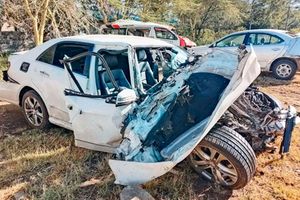Premium
COP28 meeting enters phase for environment ministers

Ms Dorcas Wakio, the CEO and founder of Mazingira Pamoja Initiative, holds a placard demanding climate justice at COP28 in Dubai, UAE, on Friday December 8.
What you need to know:
- The ministers will finalise the negotiations to produce an outcome for this year’s conference.
- Before COP28, the framework and operationalisation of the Loss and Damage facility were still obscure.
The first week of the 28th Conference of Parties (COP28) folds as negotiators take a break from back-breaking long days to hand over the second half of the climate conference to environment and climate change ministers.
The ministers will finalise the negotiations to produce an outcome for this year’s conference. The delegates attending this year’s convening are almost two times those that showed up last year in Sharm-El-Sheikh, Egypt.
This year comes with many surprises, and a tonne of hope, with countries, for the first time, reviewing their goals to assess if they have checked their boxes to ensure global warming is kept at bay. This phenomenon is like a report card that should ideally come out every five years and is called the Global Stocktake (GST).
It means that if, for example, Kenya had set a goal to double its renewable energy reach and move away from fossil fuels, the GST would take stock of how far it is with that goal. Besides the outcome, there has been a flurry of activities so far.
Also Read: ‘Earth to hit global warming limit by 2029’
On the first day, the COP presidency announced that a deal on a fund that would cater for some countries’ losses and damages due to climate change was finally taking shape.
Its creation was the biggest win for last year’s conference. The Loss and Damage facility—to be used to set aside money for climate effects that cannot be avoided through adaptation or mitigation—now has some money in it as pledged by the host country (United Arab Emirates).
For context, before the ongoing El Nino phenomenon brought the unforgiving rains, Kenya had drought, which resulted in five failed rain seasons. A report by the National Drought Management Authority earlier this year showed Kenya had lost about 2.61 million livestock to the drought. This means pastoralists had a loss they could not prevent.
Before COP28, the framework and operationalisation of the Loss and Damage facility were still obscure. So far, rich countries have pledged about 100 million Euros, to be accessed by poor nations facing the impact of climate change through the World Bank.
Even as COP president Sultan al-Jaber received cheers for setting the stage, he later in the week got some jeers due to his remarks that insinuated that there is no scientific backing for how fossil fuels affect climate change. In a rejoinder, however, he said his words were misinterpreted.
An analysis published by Kick Big Polluters Out shows that more people aligned with the oil and gas industry attended the summit this year than ever before. It raises questions about the fossil fuel debate that saw activists hold mini-protests in the COP venue to share their frustration over fossil fuel penetration despite its impact on the planet.
Kenya has, however, had some take-home from the summit so far. The country signed about seven green projects in the first few days of the conference that amounted to Sh680 billion.
President William Ruto received accolades from delegates, led by the COP president, who commended him for what he has done for climate action, calling it “unprecedented”. The momentum started from the Africa Climate Summit, which bore the Nairobi Declaration that will now form the basis of some of Africa’s demands in this summit.
At the United Nations Habitat Assembly held in June, Dr Ruto was of the idea that this year’s summit be the last to be held because action needs to start taking root after years of deliberations.
This is despite the country gaining traction globally even from the impacts of climate change. Petteri Taalas, secretary-general of the World Meteorological Organisation, highlighted in his speech when releasing the State of Climate Report 2023 in Dubai that Kenya’s flooding is a clear indication of how climate change worsens natural disasters. As of yesterday, about 200 deaths due to the floods had been reported in different parts of the country.
A day dedicated to nexus between climate change and health was a key highlight for week one. Climate and Health envoys from around the world filled the Al-Waha hall where the opening plenary was held.





